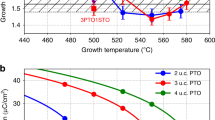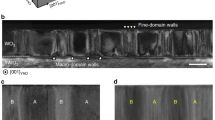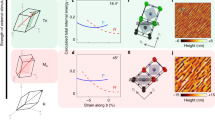Abstract
Strain engineering enables modification of the properties of thin films using the stress from the substrates on which they are grown. Strain may be relaxed, however, and this can also modify the properties thanks to the coupling between strain gradient and polarization known as flexoelectricity. Here we have studied the strain distribution inside epitaxial films of the archetypal ferroelectric PbTiO3, where the mismatch with the substrate is relaxed through the formation of domains (twins). Synchrotron X-ray diffraction and high-resolution scanning transmission electron microscopy reveal an intricate strain distribution, with gradients in both the vertical and, unexpectedly, the horizontal direction. These gradients generate a horizontal flexoelectricity that forces the spontaneous polarization to rotate away from the normal. Polar rotations are a characteristic of compositionally engineered morphotropic phase boundary ferroelectrics with high piezoelectricity; flexoelectricity provides an alternative route for generating such rotations in standard ferroelectrics using purely physical means.
This is a preview of subscription content, access via your institution
Access options
Subscribe to this journal
Receive 12 print issues and online access
$259.00 per year
only $21.58 per issue
Buy this article
- Purchase on Springer Link
- Instant access to full article PDF
Prices may be subject to local taxes which are calculated during checkout





Similar content being viewed by others
References
Rossetti, G. A., Cross, L. E. & Kushida, K. Stress induced shift of the Curie point in epitaxial PbTiO3 thin films. Appl. Phys. Lett. 59, 2524–2526 (1991).
Pertsev, N. A., Zembilgotov, A. G. & Tagantsev, A. K. Effect of mechanical boundary conditions on phase diagrams of epitaxial ferroelectric thin films. Phys. Rev. Lett. 80, 1988–1991 (1998).
Canedy, C. L. et al. Dielectric properties in heteroepitaxial Ba0.6Sr0.4TiO3 thin films: Effect of internal stresses and dislocation-type defects. Appl. Phys. Lett. 77, 1695–1697 (2000).
Sinnamon, L. J., Bowman, R. M. & Gregg, J. M. Thickness-induced stabilization of ferroelectricity in SrRuO3/Ba0.5Sr0.5TiO3/Au thin film capacitors. Appl. Phys. Lett. 81, 889–891 (2002).
Choi, K. J. et al. Enhancement of ferroelectricity in strained BaTiO3 thin films. Science 306, 1005–1009 (2004).
Haeni, J. H. et al. Room-temperature ferroelectricity in strained SrTiO3 . Nature 430, 758–761 (2004).
Catalan, G., Sinnamon, L. J. & Gregg, J. M. The effect of flexoelectricity on the dielectric properties of inhomogeneously strained ferroelectric thin films. J. Phys. Condens. Matter 16, 2253–2264 (2004).
Catalan, G., Noheda, B., McAneney, J., Sinnamon, L. J. & Gregg, J. M. Strain gradients in epitaxial ferroelectrics. Phys. Rev. B 72, 020102 (2005).
Majdoub, M. S., Maranganti, R. & Sharma, P. Understanding the origins of the intrinsic dead layer effect in nanocapacitors. Phys. Rev. B 79, 115412 (2009).
Kogan, V. D. Piezoelectric effect during inhomogeneous deformation and acoustic scattering of carriers in crystals. Sov. Phys. Solid State 5, 2069–2070 (1964).
Bursian, E. V. & Zaikovskii, O. I. Changes in the curvature of a ferroelectric film due to polarization. Sov. Phys. Solid State 10, 1121–1124 (1968).
Cross, L. E. Flexoelectric effects: Charge separation in insulating solids subjected to elastic strain gradients. J. Mater. Sci. 41, 53–63 (2006).
Zhu, W., Fu, J. Y., Li, N. & Cross, L. Piezoelectric composite based on the enhanced flexoelectric effects. Appl. Phys. Lett. 89, 192904 (2006).
Ma, W. A study of flexoelectric coupling associated internal electric field and stress in thin film ferroelectrics. Phys. Status Solidi B 245, 761–768 (2008).
Majdoub, M. S., Sharma, P. & Çağin, T. Dramatic enhancement in energy harvesting for a narrow range of dimensions in piezoelectric nanostructures. Phys. Rev. B 78, 121407 (2008).
Tagantsev, A. K., Meunier, V. & Sharma, P. Novel electromechanical phenomena at the nanoscale: Phenomenological theory and atomistic modeling. MRS Bull. 34, 643–647 (2009).
Zubko, P., Catalan, G., Welche, P. R. L., Buckley, A. & Scott, J. F. Strain-gradient-induced polarization in SrTiO3 single crystals. Phys. Rev. Lett. 99, 167601 (2007).
Maranganti, R. & Sharma, P. Atomistic determination of flexoelectric properties of crystalline dielectrics. Phys. Rev. B 80, 054109 (2009).
Hong, J., Catalan, G., Scott, J. F. & Artacho, E. The flexoelectricity of barium and strontium titanates from first principles. J. Phys. Condens. Matter 22, 112201 (2010).
Gruverman, A. et al. Mechanical stress effect on imprint behavior of integrated ferroelectric capacitors. Appl. Phys. Lett. 83, 728–730 (2003).
Tagantsev, A. K., Cross, L. E. & Fousek, J. Domains in Ferroelectric Crystals and Thin Films 637 (Springer, 2010).
Lee, D. et al. Giant flexoelectric effect in ferroelectric epitaxial thin films. Phys. Rev. Lett. 107, 057602 (2011).
Vrejoiu, I. et al. Intrinsic ferroelectric properties of strained tetragonal PbZr0.2Ti0.8O3 obtained on layer-by-layer grown, defect-free single-crystalline films. Adv. Mater. 18, 1657–1661 (2006).
Catalan, G. et al. Polar domains in lead titanate films under tensile strain. Phys. Rev. Lett. 96, 127602 (2006).
Pompe, W., Gong, X., Suo, Z. & Speck, J. S. Elastic energy release due to domain formation in the strained epitaxy of ferroelectric and ferroelastic films. J. Appl. Phys. 74, 6012–6019 (1993).
Zeches, R. J. et al. A strain-driven morphotropic phase boundary in BiFeO3 . Science 326, 977–980 (2009).
Qiu, Q. Y., Nagarajan, V. & Alpay, S. P. Film thickness versus misfit strain phase diagrams for epitaxial PbTiO3 ultrathin ferroelectric films. Phys. Rev. B 78, 064117 (2008).
Bellaiche, L., Garcia, A. & Vanderbilt, D. Finite-temperature properties of Pb(Zr1−xTix)O3 alloys from first principles. Phys. Rev. Lett. 84, 5427–5430 (2000).
Fu, H. & Cohen, R. E. Polarization rotation mechanism for ultrahigh electromechanical response in single-crystal piezoelectrics. Nature 403, 281–283 (2000).
Guo, R. et al. Origin of the high piezoelectric response in PbZr1−xTixO3 . Phys. Rev. Lett. 84, 5423–5426 (2000).
Speck, J. S. & Pompe, W. Domain configurations due to multiple misfit relaxation mechanisms in epitaxial ferroelectric thin films. I. Theory. J. Appl. Phys. 76, 466–476 (1994).
Pertsev, N. A. & Zembilgotov, A. G. Energetics and geometry of 90° domain structures in epitaxial ferroelectric and ferroelastic films. J. Appl. Phys. 78, 6170–6180 (1995).
Vlooswijk, A. H. G. et al. Smallest 90° domains in epitaxial ferroelectric films. Appl. Phys. Lett 91, 112901 (2007).
Kwak, B. S. et al. Strain relaxation by domain formation in epitaxial ferroelectric thin films. Phys. Rev. Lett. 68, 3733–3736 (1992).
Kwak, B. S. et al. Domain formation and strain relaxation in epitaxial ferroelectric heterostructures. Phys. Rev. B 49, 14865–14879 (1994).
Ivry, Y., Chu, D. P. & Durkan, C. Bundles of polytwins as meta-elastic domains in the thin polycrystalline simple multi-ferroic system PZT. Nanotechnology 21, 065702 (2010).
Pietsch, U., Holy, V. & Baumbach, T. High-Resolution X-Ray Scattering: From Thin Films to Lateral Nanostructures (Springer, 2004).
Walker, D., Thomas, P. A. & Collins, S. R. A comprehensive investigation of the structural properties of ferroelectric PbZr0.2Ti0.8O3 thin films grown by PLD. Phys. Status Solidi A 206, 1799–1803 (2009).
Nellist, P. D. et al. Direct sub-angstrom imaging of a crystal lattice. Science 305, 1741 (2004).
Nelson, C. T. et al. Spontaneous vortex nanodomain arrays at ferroelectric heterointerfaces. Nano Lett. 11, 828–834 (2011).
Hytch, M. J., Snoeck, E. & Kilaas, R. Quantitative measurement of displacement and strain fields from HREM micrographs. Ultramicroscopy 74, 131–146 (1998).
GPA Phase plug-in for DigitalMicrograph (Gatan) (HREM Research Inc.) available at: http://www.hremresearch.com.
Ma, W. & Cross, L. E. Strain-gradient-induced electric polarization in lead zirconate titanate ceramics. Appl. Phys. Lett. 82, 3293–3295 (2003).
Hellwege, K-H. & Hellwege, A. M. (eds) Landolt–Bornstein: Numerical Data and Functional Relationships in Science and Technology (New Series—Group III, Vol. 16a, Springer, 1981).
Cohen, R. E. Origin of ferroelectricity in perovskite oxides. Nature 358, 136–138 (1992).
Jia, C-L. et al. Unit-cell scalemapping of ferroelectricity and tetragonality in epitaxial ultrathin ferroelectric films. Nature Mater. 6, 64–69 (2007).
Muralt, P. The emancipation of ferroelectricity. Nature Mater. 6, 8–9 (2007).
Rossetti, G. A. Jr, Zhang, W. & Khachaturyan, A. G. Phase coexistence near the morphotropic phase boundary in lead zirconate titanate (PbZrO3–PbTiO3) solid solutions. Appl. Phys. Lett. 88, 072912 (2006).
Noheda, B. & Cox, D. E. Bridging phases at the morphotropic boundaries of lead oxide solid solutions. Phase Transit. 79, 5–20 (2006).
Davis, M. Picturing the elephant: Giant piezoelectric activity and the monoclinic phases of relaxor-ferroelectric single crystals. J. Electroceramics 19, 23–45 (2007).
Ahn, S. J., Kim, J-J., Kim, J-H. & Choo, W-K. Origin of polar domains in ferroelectric relaxors. J. Korea Phys. Soc. 42, S1009–S1011 (2003).
Nagarajan, V. et al. Dynamics of ferroelastic domains in ferroelectric thin films. Nature Mater. 2, 43–47 (2003).
Koster, G., Kropman, B. L., Rijnders, G. J. H. M., Blank, D. H. A. & Rogalla, H. Quasi-ideal strontium titanate crystal surfaces through formation of strontium hydroxide. Appl. Phys. Lett. 73, 2920–2922 (1998).
Acknowledgements
W. Caliebe is gratefully acknowledged for his help at the W1 beamline. This work is part of research programme 04PR2359 of the Foundation for Fundamental Research on Matter (FOM), which is part of the Netherlands Organisation for Scientific Research (NWO). G.C., A.H.G.V. and B.N. also acknowledge financial support from the NWO-Vidi grant 700.54.426, and from the Explora grant MAT2010-10067-E (G.C.). A.L. and E.S. acknowledge financial support from the European Union under the Framework 6 program under a contract for an Integrated Infrastructure Initiative. Reference 026019 ESTEEM.
Author information
Authors and Affiliations
Contributions
G.C. and B.N. have devised, designed and organized the work; A.H.G.V. and A.J. have grown the films under the supervision of G.R. and D.H.A.B.; A.H.G.V., G.C., G.R. and B.N. have carried out the X-ray experiments and analysed the X-ray data; A.L., E.S. and C.M. have designed, carried out and organized the electron microscopy experiments and analysed the data. All the authors have contributed to the discussions.
Corresponding authors
Ethics declarations
Competing interests
The authors declare no competing financial interests.
Rights and permissions
About this article
Cite this article
Catalan, G., Lubk, A., Vlooswijk, A. et al. Flexoelectric rotation of polarization in ferroelectric thin films. Nature Mater 10, 963–967 (2011). https://doi.org/10.1038/nmat3141
Received:
Accepted:
Published:
Issue Date:
DOI: https://doi.org/10.1038/nmat3141
This article is cited by
-
Exact inversion of partially coherent dynamical electron scattering for picometric structure retrieval
Nature Communications (2024)
-
A 2D ferroelectric vortex pattern in twisted BaTiO3 freestanding layers
Nature (2024)
-
Flexoelectric effect via piezoresponse force microscopy of domain switching in epitaxial PbTiO3 thin films
Journal of the Korean Ceramic Society (2024)
-
Bowing to ferroelectric artificial flux closure
Nature Materials (2023)
-
Static and dynamic flexoelectric effects on wave propagation in microstructured elastic solids
Indian Journal of Physics (2023)



